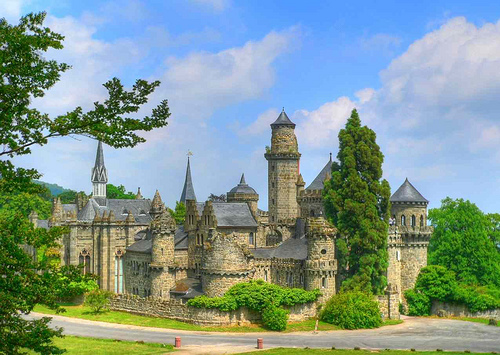

Location: Kassel, Hesse Map
Constructed: 1793- 1800
Museum open: 10am- 5pm Tue- Sun (each hour)
Tel: +49 (0)561 3 16 80-244
Fax: +49 (0)561 3 16 80-222
Löwenburg Castle is residence situated near town of Kassel in the region of Hesse in Germany. Löwenburg Castle was designed by Christoph Heinrich Jussow and constructed in 1793- 1800. The castle architecture was influenced by the medieval German castles. A collection of 16th and 17th century weapons inside further increased the similarities. Its first resident Wilhem IX lived here for 21 years and after his death was buried underneath the castle chapel. Much of the dungeon and parts of the castles was destroyed by the RAF (Royal Air Force- British) night raids during World War II. Neighboring town of Kassel suffered a worse bombings that wiped out 90% of the original city.
The castle, modeled on a hilltop castle, was designed by Heinrich Christoph Jussow between 1793 and 1801, centuries after the actual construction phase of castles in Germany. It is the imitation of a medieval knight's castle and, romantically historicizing, was deliberately built as an artificial ruin. Initially only planned as a ruinous tower with an outbuilding, a complete castle complex was finally created, which is grouped around an inner courtyard. The complex served the landgrave as a residence for himself and his mistress Karoline von Schlotheim. In 1821, the Landgrave, who was elected Elector Wilhelm I in 1803, was buried in the crypt under the castle chapel. The Löwenburg was built from the very beginning of the hawk forest tuff, which was not very weather-resistant, was available near the construction site and is easy to work on.
Until 1945, the Royal Air Force and the United States Army Air Forces carried out several attacks on Kassel. The city experienced the heaviest attack on October 22nd, 1943. Due to the armaments industry and especially the dense development in the old town area with the easily fire-catching half-timbered houses, Kassel was early on in the list of cities in accordance with the Area Bombing Directive for which an incendiary attack was particularly important seemed suitable. The keep of the Löwenburg was largely destroyed (all that remained was the stair tower with some remains of the wall) and large parts of the complex, including the kitchen and connector construction, were badly damaged. The reconstruction took place in the post-war years and was characterized more by functionality than by attention to detail. In 1957, extensive renovation work was carried out in the women's building with the aim of being able to collect salvaged inventory from the destroyed keep. The work has not yet been completed. The keep is currently being reconstructed and is to be reopened in 2022 with a 25-meter viewing platform.
The interiors consist of four princely apartments in baroque style. In an armory there are numerous historical weapons and plate armor from the 16th and 17th centuries. The castle chapel is furnished with numerous objects from medieval churches from the North Hessian area and has a crypt with the sarcophagus of the elector under the choir. Numerous items of equipment from the historical collection that were relocated during the war are still in depots or are exhibited at Friedrichstein Castle. You should not return until the castle has been rebuilt. The interiors can be viewed on guided tours.
In 1922 Georg Jacoby shot
parts of his film “This is how men are” in the castle. In this film
Marlene Dietrich had her first small role.
In 2010, episode
19 of 22 of the TV series Pfarrer Braun was filmed in Löwenburg,
which has since been broadcast several times on German-language
television. Ottfried Fischer in the main role plays a priest who is
active in crime and is on the trail of a murder. The Löwenburg
serves as a rectory and crime scene.
The film Grand Budapest
Hotel begins with the property of the main character Zéro Moustafa
and, among other things, briefly fades in a picture of the Lion
Castle showing it from the south.
On January 2, 2016,
Deutsche Post AG issued a 90 cents stamp as part of its special
stamp series Castles and Palaces, which shows the Löwenburg in
winter. The design comes from Nicole Elsenbach and Franc Fienbork.